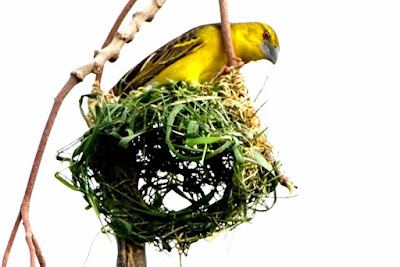 |
| Red-headed Weaver, seen near Dete, Zimbabwe, Africa |
Early each morning I walked
along the road observing and photographing birds. The abundance, diversity and
beauty of Zimbabwe's birds were a continual source of enjoyment for me. The beautiful Red-headed Weaver, seen above,
builds its nests in smaller colonies than does the Southern Masked Weaver I wrote about in last week's post.
Some of the most intriguing
interactions I witnessed were between two different species. Here, a fledgling
Jacobin Cuckoo begs for food from its host parent, a Dark Capped (Common)
Bulbul.
Cuckoos are brood
parasites that lay their eggs in the nests of other species who (for the most
part) accept the egg and expend their time and energy rearing the parasites'
young, often along with their own. The cuckoos' strategy demands close
cooperation between male and female. Together they quietly approach a potential
host nest. The male cuckoo starts calling to distract the host. Eventually he
perches just above the nest, taunting the host. When the host leaves the nest
to attack the intrusive male, the female cuckoo moves in and lays her egg. Then
the cuckoo pair flies off, leaving their genetic legacy to the (hopefully) good
parenting skills of the host.
Five days later I saw
the young cuckoo again with its host parent. It looked to me like the cuckoo
had grown and was now using its size and and perhaps aggressive nature to bully
the bulbul. The cuckoo would relentlessly thrust its bill at the host parent,
until it would finally fly off in search of another meal. At other times the
host parent, probably by now exhausted, appeared to resist: a standoff.
Whenever the cuckoo
finished eating what the bulbul had brought to it, the bullying began again.
Often I used my
photos, like this one of the Red-backed Shrike, to identify a bird with my
app once I was back home.
Striped Kingfisher with an insect in its bill.
Many kingfishers feed on insects, reptiles, and frogs, even small mammals,
either exclusively or more frequently than on fish and other aquatic creatures.
When I photographed
this Yellow-billed Hornbill I thought it was eating a flower. Enlarging the
image revealed that it was actually a moth.
The Laughing Dove is distinguished by its blue wings.
The Tropical Boubou's
call is lovely, haunting. I only saw it making that sound once, or I would have
forever been mystified. When the bird was foraging low in the foliage or on the
ground for insects, I could often see that it was uttering a completely
different call, hoarser, and more coarse.
By eight a.m., the
sun was burning away the cool, fresh morning air and I headed home, eager to
rehydrate, look at my new photos, and identify new bird sightings.
















